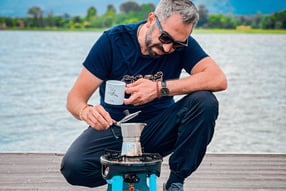8 Ways to purify water
Ensuring access to clean and safe drinking water is crucial during disasters. There are several methods to purify water, each with its own steps. Here's a detailed guide on how to clean water using eight different methods, step by step:
1. Boiling:
Steps:
Gather Water: Collect water from the cleanest source available.
Boiling: Place the water in a clean pot and bring it to a rolling boil.
Duration: Boil the water for at least one minute (or three minutes at higher altitudes) to kill most microorganisms.
Cooling: Let the water cool down before drinking or storing it in clean containers.
2. Chlorination:
Steps:
Collect Water: Gather water in a clean, large container.
Chlorine Solution: Add regular household bleach (unscented) containing 5-6% sodium hypochlorite. Use 8 drops of bleach per gallon of water (or 2 drops per liter).
Mixing: Stir the water and bleach solution well and let it sit for 30 minutes.
Smell Check: After 30 minutes, if you can still smell chlorine, repeat the dosage and wait for an additional 15 minutes.
Safe to Drink: If there is a faint smell of chlorine, the water is safe to drink.
3. Iodine Tablets:
Steps:
Fill Container: Fill a clean container with the water to be purified.
Add Tablets: Drop the appropriate number of iodine tablets as per the instructions. Typically, one tablet per quart or liter is used.
Wait Time: Wait for about 30 minutes (or as per the tablet instructions) to allow iodine to disinfect the water.
Taste Test: If the water has a slight iodine taste after the waiting period, it is safe to drink.
4. Filtration:
Steps:
Select Filter: Choose a water filter that is designed to remove bacteria, protozoa, and other contaminants.
Preparation: Set up the filter according to the manufacturer’s instructions.
Pumping: Pump the water through the filter. Most portable filters require manual pumping.
Collection: Collect the filtered water in a clean container.
Storage: Store the filtered water in a clean, covered container to prevent recontamination.
5. Distillation:
Steps:
Boiling: Boil water to create steam.
Condensation: Collect the steam and allow it to cool and condense back into liquid form.
Collection: Collect the condensed liquid. The impurities are left behind during the distillation process.
Safe to Drink: The collected liquid is now purified and safe to drink.
6. Solar Disinfection (SODIS):
Steps:
Clear Bottles: Fill clear PET plastic bottles with water to be purified.
Sun Exposure: Place the bottles in direct sunlight for 6 hours (if sunny) or 2 days (if cloudy) to allow UV rays to kill pathogens.
Safe to Drink: After exposure, the water is safe to drink. Use a dark cloth or box to prevent recontamination during exposure.
7. Activated Charcoal Filtration:
Steps:
Prepare the Filter: Create a filter using activated charcoal by placing it in a container with a layer of sand on top.
Pour Water: Pour the water through the charcoal and sand filter.
Collection: Collect the filtered water in a clean container placed below the filter.
Storage: Store the filtered water in covered containers to maintain its purity.
8. Aluminum Sulfate (Alum) Flocculation:
Steps:
Dissolve Alum: Dissolve alum powder in the water. Use 1-2 grams of alum per liter of water.
Mix Thoroughly: Stir the solution thoroughly and let it sit undisturbed for 1-2 hours.
Settling: After the waiting period, the impurities will settle at the bottom of the container.
Careful Pouring: Carefully pour off the clarified water from the top, leaving the sediment behind.
Additional Filtration: For extra safety, filter the clarified water through a cloth or fine mesh before drinking.
Remember, each method has its limitations, and it's crucial to assess the specific situation and choose the most appropriate method. Also, ensure that all containers and utensils used in the process are clean to prevent recontamination of the purified water.


